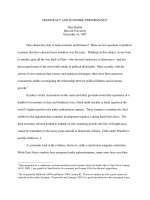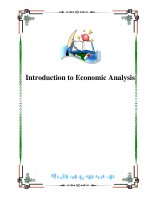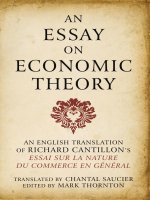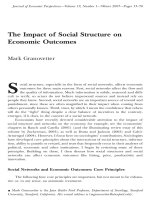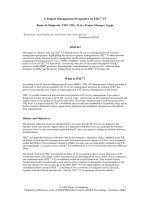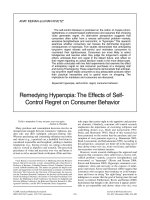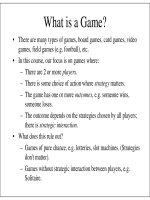Essay on Economic Theory pptx
Bạn đang xem bản rút gọn của tài liệu. Xem và tải ngay bản đầy đủ của tài liệu tại đây (2.62 MB, 254 trang )
An
Essay on
Economic
Theory
An English translation
of Richard Cantillon’s
Essai sur la Nature
du Commerce en Général
An
Essay on
Economic
Theory
An English translation of Richard Cantillon’s
Essai sur la Nature du Commerce en Général
Translated by Chantal Saucier
Edited by Mark ornton
4 An Essay on Economic eory
© 2010 by the Ludwig von Mises Institute and published under the
Creative Commons Attribution License 3.0.
/>Ludwig von Mises Institute
518 West Magnolia Avenue
Auburn, Alabama 36832
mises.org
ISBN: 978-1-61016-001-8
Foreword
Robert F. Hébert
FOLLOWING A CENTURY of neglect, William Stanley Jevons, in the
rst blush of discovery, proclaimed Cantillon’s Essai, “the cradle of politi-
cal economy.” Subsequent growth and development of economic thought
has not really alerted us to the subtleties of this succinct appraisal. A cra-
dle holds new life; and there can be little doubt that the Essai added new
life to the organizing principles of economics. But “political economy”
does not accurately describe the subject Cantillon addressed. Indeed,
he scrupulously avoided political issues in order to concentrate on the
mechanics of eighteenth-century economic life. When confronted by
“extraneous” factors, such as politics, Cantillon insisted that such consid-
erations be put aside, “so as not to complicate our subject,” he said, thus
invoking a kind of ceteris paribus assumption before it became fashion-
able in economics to do so.
is is merely one way in which Cantillon was ahead of his time. He
preceded Adam Smith by a generation. Both writers made important
foundational contributions to economics, but from perspectives that were
quite dierent. Smith was a philosopher and educator. His approach to
economics reected the concerns and approaches of philosophic inquiry
stretching back to omas Hobbes. e Hobbesian dilemma was how to
secure peace and prosperity without submitting to an all-powerful central
government. Smith gave an answer based on the nature and function of an
exchange economy operating under a rule of law. e Wealth of Nations
is full of useful advice to those who hold political power. Hence, Smith
earned his sobriquet “father of political economy.”
Cantillon was a businessman and banker. His approach to econom-
ics reected the concerns of practical men who set about making a liv-
ing, and his analysis concentrated on the structure and mechanics of an
emerging market economy. e economy he described was an enterprise
5
6 An Essay on Economic eory
economy, not a political one, in which certain individuals played key roles,
some passive and some active. Government, as we know it, was relatively
passive in Cantillon’s economy. e most active and central participant
was the entrepreneur, who motivates the entire economic system. Unlike
any previous writer, Cantillon explicated the vital role of the entrepreneur
with perception and vigor. Hence, he deserves to be called “the father of
enterprise economics.”
ese considerations alone would justify renewed interest in Cantillon
and his work, but there have always been impediments to overcome. We
know little of Cantillon’s life and the circumstances of his authorship. e
manuscript that was eventually published in 1755 circulated privately in
France for almost two decades before; when published, it appeared under
mysterious circumstances. e designated publisher, Fletcher Gyles, never
existed at the address given; and despite the phrase “traduit de l’Anglois”
on the title page, no English original was ever found. Moreover, a statisti-
cal supplement to the Essai has gone missing, and has never been discov-
ered. In the 1970s a Japanese scholar unearthed a French manuscript at the
municipal library in Rouen bearing the title, “Essay De la Nature Du Com-
merce en Général,” which encouraged speculation that the rst word may
have been carelessly transcribed from an English original, still undiscov-
ered. All of this has given economic detectives much to si through and
explain. But the one steadfast realization throughout has been the power of
Cantillon’s analysis.
Mark Thornton and Chantal Saucier have accomplished the ardu-
ous task of bringing forth a new and improved translation of Cantillon’s
famous work. Heretofore the only English translation of the Essai avail-
able has been the 1931 edition produced by Henry Higgs for the Royal
Economic Society. ough competent, it has become less serviceable over
time, as more and more of its shortcomings devolved (not the least of
which is the antiquated use of “undertaker” in place of “entrepreneur”).
Saucier provides a more accurate and lucid account, better suited to the
21st century. ornton’s hand shows not only in competent guidance of
the translator but in the inclusion of numerous explanatory footnotes that
add historical context.
Age has dimmed my memory of the exact hour and day, but when I
was much younger I presented a paper on Cantillon to a small group of
economists gathered in Keynes Hall at Cambridge University. Aerward
Saucier / ornton 7
I was approached by a proper English gentleman who wished to discuss
further the merits of Cantillon’s work. During the ensuing conversation I
mentioned my belief that a new translation of the Essai was warranted. My
listener enthusiastically agreed. At some point it dawned on me that he had
not mentioned his name. So I asked. “Shackle,” he replied. I was momen-
tarily stunned. G. L. S. Shackle (1903-1992) was Britain’s leading intellect
on the themes that are central to Cantillon’s analysis, namely imagination
and uncertainty. If he were alive today, I’m sure Shackle would welcome
this new translation, alongside the rest of us who have an abiding interest
in Cantillon and his ideas.
8 An Essay on Economic eory
Saucier / ornton 9
Contents
Introduction by Chantal Saucier and Mark ornton . . . . . . . . . . . 13
Part One:
Production, Distribution, and Consumption
Chapter One:
Wealth . . . . . . . . . . . . . . . . . . . . . . . . . . 21
Chapter Two:
Human Societies. . . . . . . . . . . . . . . . . . . . . 23
Chapter Three:
Villages . . . . . . . . . . . . . . . . . . . . . . . . . . 27
Chapter Four:
Market Towns . . . . . . . . . . . . . . . . . . . . . . 31
Chapter Five:
Cities . . . . . . . . . . . . . . . . . . . . . . . . . . . 35
Chapter Six:
Capital Cities. . . . . . . . . . . . . . . . . . . . . . . 39
Chapter Seven:
e Labor of the Plowman is of less Value
than that of the Artisan . . . . . . . . . . . . . . . . 41
Chapter Eight:
Some Artisans earn more, others less,
according to the dierent Cases and
Circumstances . . . . . . . . . . . . . . . . . . . . . . 45
Chapter Nine:
e Number of Laborers, Artisans and
others, who work in a State is naturally
proportioned to the Demand for them . . . . . . . . 49
Chapter Ten:
e Price and Intrinsic Value of a ing
in general is the measure of the Land and
Labor which enter into its Production . . . . . . . . 53
Chapter Eleven:
e Par or Relation between the Value of
Land and Labor . . . . . . . . . . . . . . . . . . . . . 59
Chapter Twelve:
All Classes and Individuals in a State
subsist or are enriched at the Expense of the
Proprietors of Land . . . . . . . . . . . . . . . . . . . 69
Chapter Thirteen:
e Circulation and Exchange of
Goods and Merchandise as well as their
Production are carried on in Europe by
Entrepreneurs, and at a risk . . . . . . . . . . . . . . 73
9
10 An Essay on Economic eory
Chapter Fourteen:
e Desires, Fashions, and the Ways of Life
of the Prince, and especially of the Property
Owners, determine the Use to which Land
is put in a State and Cause the Variations in
the Market Prices of all ings. . . . . . . . . . . . . 79
Chapter Fifteen:
e Increase and Decrease of the Number
of People in a State chiey Depends on the
Taste, the Fashions, and the Ways of Life
Property Owners . . . . . . . . . . . . . . . . . . . . 85
Chapter Sixteen:
e more Labor there is in a State the more
the State is judged naturally rich. . . . . . . . . . . . 97
Chapter Seventeen:
Metals and Money,
and especially of Gold and Silver . . . . . . . . . . 103
Part Two: Money and Interest
Chapter One:
Barter . . . . . . . . . . . . . . . . . . . . . . . . . . 115
Chapter Two:
Market Prices . . . . . . . . . . . . . . . . . . . . . 119
Chapter Three:
e Circulation of Money . . . . . . . . . . . . . . 123
Chapter Four:
Further Reection on the Rapidity or
Slowness of the Circulation of Money
in Exchange . . . . . . . . . . . . . . . . . . . . . . 133
Chapter Five:
e inequality of the circulation of
hard money in a State . . . . . . . . . . . . . . . . . 139
Chapter Six:
e increase and decrease in the quantity of
hard money in a State . . . . . . . . . . . . . . . . . 147
Chapter Seven:
Continuation of the same subject . . . . . . . . . . 155
Chapter Eight:
Further Reection on the same subject. . . . . . . 159
Chapter Nine:
e Interest of Money and its Causes . . . . . . . . 169
Chapter Ten:
e Causes of the Increase and Decrease of
the Interest of Money in a State . . . . . . . . . . . 177
10
Saucier / ornton 11
Part Three: International Trade and Business Cycles
Chapter One:
Foreign Trade . . . . . . . . . . . . . . . . . . . . . 185
Chapter Two:
e Nature of Exchange Rates . . . . . . . . . . . . 195
Chapter Three:
Further explanations of the Nature
of Exchange Rates . . . . . . . . . . . . . . . . . . . 203
Chapter Four:
e variations in the proportion of
values with regard to the Metals which
serve as Money. . . . . . . . . . . . . . . . . . . . . 209
Chapter Five:
e augmentation and diminution
of coin in denomination . . . . . . . . . . . . . . . 219
Chapter Six:
Banks and their Credit . . . . . . . . . . . . . . . . 227
Chapter Seven:
Further explanations and enquiries as to
the utility of a National Bank . . . . . . . . . . . . 233
Chapter Eight:
Renements of Credit of General Banks . . . . . . 241
11
12 An Essay on Economic eory
Saucier / ornton 13
Introduction
E
ssai sur la Nature du Commerce en Général should be rightfully con-
sidered one of the most important books ever written. It is the rst
statement of economic theory and not just a single or limited break-
through, but a comprehensive treatment that explains the organization of
commercial society. Prior to Cantillon, writings about the economy were
largely driven by considerations of religion, ideology, and interests groups.
Aer Cantillon, there was a scientic model that could be understood and
applied. Most importantly, when it was properly understood and applied,
it unleashed the market economy and generated great prosperity.
Early in his career, Cantillon worked for a war proteer in the British
government and later for John Law in the Mississippi Company scheme.
His rst job enabled him to establish a bank in Paris from which he grew
rich. Cantillon made a fortune on the value of his shares in the company
during the Mississippi Bubble. Subsequently he made more money by sell-
ing shares short during the bust and by taking advantage of changes in
exchange rates that he correctly anticipated. Aer the Bubble, he was one
of the wealthiest private individuals in the world.
Not unlike the modern day nancial scandals, Cantillon was hounded
by lawsuits and criminal charges, so much so that his biographer, Antoin
Murphy, suggests that rather than being murdered in 1734, Cantillon actu-
ally faked his death and made o with his money to South America.
Based on the book itself and other evidence, we are now reasonably
condent that Cantillon completed the manuscript in 1730. It could never
have been published under the harsh French censorship laws that pre-
vailed throughout the rst half of the 18th century and, as a result, it only
circulated privately in hand-copied manuscripts. Only aer the censorship
13
14 An Essay on Economic eory
laws were relaxed was it published in 1755, and even then, it was published
anonymously under the name of a defunct foreign publisher.
Least you think the Essai is a dry technical practitioner’s guide to the
economy, it should be stressed that Cantillon deals with a wide variety of
fundamental and philosophical issues such as the nature of property, the
distribution of income, the origin of money, and the role of government.
He even criticized an early version of the Malthusian Population theory
and oered an accurate prediction of the population of the United States in
the 19th century.
Cantillon’s circle of friends and acquaintances reads like a who’s who
of the early 18th century intellectuals. His good friend was Lord Boling-
broke, a former Prime Minister of England and a leader of the Jacobite
cause. Cantillon met many of the leading intellectuals of the day through
Bolingbroke, such as Montesquieu and Voltaire in France and probably
Jonathan Swift and Alexander Pope in connection with Bolingbroke’s
political activities in England. ere is evidence to suggest that, in addi-
tion to the infamous John Law, Cantillon also knew and was critical of the
economist Charles Davenant and Sir Isaac Newton, who was the director
of the Royal Mint.
Cantillon opposed the ruling elite and was friendly with opposition
leaders in both of the two great warring powers, England and France.
He provided the theoretical superstructure that justied the opposition
agenda against big government and showed how taxes, regulations, war,
and a large national debt impoverish the people.
Cantillon began his challenge to accepted doctrine on page one when
he showed that money was just a medium of exchange and that wealth
was not money, but the ability to consume. He demonstrated that the best
way to produce consumer goods was to allow free markets where entre-
preneurs could be counted on to make self-interested judgments on what
would best please their consumers.
Cantillon’s model of the isolated estate is a conceptual analysis of the
emergence of the market economy from feudalism. It is the inspiration for
Adam Smith’s invisible hand because it demonstrates that entrepreneurial
self-interest will regulate the economy of the isolated estate just as well or
better than if the estate owner continued to make all the decisions.
Saucier / ornton 15
e inuence of Cantillon’s manuscript was largely unknown and the
book had fallen so far into neglect that William Stanley Jevons was said to
have “rediscovered” it in the late 19th century. However, we now know that
it had a tremendous inuence on the development of economics. In addi-
tion to Adam Smith, it has now been shown that fellow Scotsman David
Hume read the manuscript in some form before publishing his own path-
breaking contributions to economics. In France, Mirabeau had a copy for
many years and used it as the basis of his many popular works on econom-
ics. e publication of the Essai played a pivotal role in the formation of the
Physiocrat School of economics in the late 1750s. We also know that it was
very inuential on the economic thought of Turgot, Condillac, and Jean-
Baptiste Say, and subsequently on the French Liberal School that followed.
We can also now say that Cantillon was an important inuence on Carl
Menger, Ludwig von Mises, and Noble Laureate F. A. Hayek, of the Aus-
trian School of economics, and that he provided the “Cantillon Eects,”
which are central to the Austrian theory of the business cycle.
Cantillon’s contributions span the entire gamut of economics includ-
ing entrepreneurship, methodology, theory, microeconomics, macroeco-
nomics, international trade and nance, economic policy, and even areas
such as population theory, economic geography, and transport economics.
If you want to know the scientic “magic” of the market, here is the man
who literally wrote the book.
e case for the book is compelling and so is the case for a new Eng-
lish translation. First, the Essai presents material that is brilliant, but di-
cult. Even the original French manuscript must have appeared incredibly
complex to his early readers, a point noted by Cantillon himself in the text.
Aer all, this was a new science that was fully born in one long stroke of
his pen. Remember further that Cantillon died shortly aer writing the
book and that it was not published until long aer his personal associates
had died, so there was no one to clarify matters.
Second, the English translation by Henry Higgs is a faithful interpre-
tation, but one that is wholly out of date and which provides little guid-
ance for the reader. In the introduction to the rst English edition of the
Essai sur la Nature du Commerce en Général, published in 1931, Henry
Higgs states that his translation “follows the French text of 1755 with all
faults of grammar, spelling, accent and punctuation.” Higgs chose faith-
fulness over beauty, sometimes perhaps to the detriment of readability.
16 An Essay on Economic eory
roughout history, translators have wrestled with the same question or
dilemma: balancing faithfulness with beauty. Much as with English, the
French language has changed tremendously since the early 18th century,
when Cantillon wrote the Essai. A faithful translation, therefore, renders
the text in a language that is no longer in use. Our goal diers from that
of Higgs in that we want Cantillon’s book to be accessible to the modern
reader. Higgs’ translation can only be roughly understood, and in some
important instances, is in error.
We remedy these shortfalls in a variety of ways. First, we modernized
the text, especially but not limited to capitalization, punctuation, and sen-
tence structure. Second, we have changed the 20th century British transla-
tion to reect terminology of more modern times and we believe that this
also provides value and clarity. For example, Higgs translated “intendans
ou inspecteurs”—which means administrators or supervisors—into “stew-
ards and bailis,” leaving the modern American thinking about airplanes
and courtrooms. He also translated “habillement” as “rayment” instead of
clothing. In some cases, we restore the text closer to the original French
version. An important example of this restoration is Higgs’ translation of
the word “entrepreneur”—which plays a central role in Cantillon’s model
of the economy—into “undertaker.”
Third, we provide explanatory footnotes that describe the people,
places, events, weights, measures and currency values that Cantillon used,
and which are no longer commonly understood, as well as descriptions
and rationales for any substantive changes from the Higgs translation.
Fourth, we provide abstracts for chapters and provide titles for the sec-
tions. We also provide graphic illustrations for some of Cantillon’s impor-
tant contributions, such as the circular-ow diagram of the economy, in
order to aid comprehension. We liken the process to restoring a painting
or ne piece of furniture—not changing the original—just cleaning it, x-
ing a few scratches, and putting on a new coat of varnish. is new trans-
lation, we hope, will appeal to new readers and seasoned economists alike
and give Cantillon’s Essai the attention that it well deserves.
e task of retranslating the Essai sounded like a simple and straight-
forward project for which we completely underestimated the time and dif-
culty involved. It has taken several years and unknown hours of work
to complete, and we fully acknowledge that it could be better. Finally, we
would like to acknowledge the assistance and encouragement of historians
Saucier / ornton 17
of economic thought William Breit, Robert Ekelund, Guido Hülsmann,
and especially of Robert Hébert. Historians Donna Bohannon, Joseph
Stromberg, and omas Woods were also of great assistance. We thank
Paul Wicks for copyediting the manuscript. We wish to thank Paul Wicks
for copy editing the manuscript and our family and friends, especially Bill
Curlee for their support.
18 An Essay on Economic eory
Saucier / ornton 19
P a r t O n e
Production,
Distribution,
and Consumption
19
20 An Essay on Economic eory
Saucier / ornton 21
Chapter One
Wealth
Abstract: Cantillon defines wealth as the consumption
goods produced by land and labor. is contrasted with
the Mercantilists who thought money was wealth.
LAND IS THE SOURCE or matter from which all wealth is drawn; man’s
labor provides the form for its production, and wealth in itself is nothing
but the food, conveniences, and pleasures of life.
Land produces grass, roots, grain, ax, cotton, hemp, shrubs and sev-
eral kinds of trees, with fruits, bark, and foliage like that of the mulberry
tree for silkworms, and it supplies mines and minerals. From these, the
labor of man creates wealth.
Rivers and seas provide fish for the food of man, and many other
things for his enjoyment. But these seas and rivers belong to the adjacent
lands or are common to all, and man’s labor extracts sh and other advan-
tages from them.
21
22 An Essay on Economic eory
Saucier / ornton 23
Chapter Two
Human Societies
Abstract: All human societies are based on a system of
property rights. e distribution of rights will necessarily
be unequal, and the use to which property is put will be
dependent on the tastes of the owners.
WHICHEVER WAY A SOCIETY of men is formed, the ownership of
the land they inhabit will necessarily belong to a small number among
them.
In nomadic societies like the Tartar hordes
1
and Indian tribes, who
go from one place to another with their animals and families, the king or
leader must x the boundaries for households and neighborhoods around
the camp. Otherwise, there would always be disputes over living quarters
or access to life’s conveniences such as forests, pastures, water, etc. How-
ever, when the districts and boundaries are settled for all, it is as good as
ownership while they stay in that place.
In the more settled societies, if a prince at the head of an army has
conquered a country, he will distribute the lands among his ocers or
friends according to their merit or his pleasure (as was originally the case
in France). He will then establish laws to maintain property rights for them
and their descendants, or he will reserve the ownership of the land to him-
self and employ his ocers or friends to cultivate it. He also may grant
the land to them on condition that they pay an annual royalty or rent, or
1
e Mongols, under Genghis Khan captured territories from the Pacic Ocean to Poland and
from Russia to the Middle East and India and established the Mongol Empire, the largest conti-
gous empire in world history during the 13th and 14th centuries.
23
24 An Essay on Economic eory
he may grant it to them while reserving the right to tax them every year
according to his needs and their capacity. In all these cases, the ocers or
friends, whether independent owners or dependents, whether administra-
tors or supervisors of the production of the land, will be few in number
compared to all the inhabitants.
Even if the prince distributes the land equally among all the inhabit-
ants, it will ultimately be divided among a small number. One man will
have several children and will not be able to leave each of them a portion
of land equal to his own. Another will die without children, and will leave
his portion to someone who has land already, rather than to one who has
none. A third will be lazy, extravagant, or sickly, and be obliged to sell his
portion to someone more frugal and industrious, who will continually add
to his estate by new purchases on which he will employ the labor of those,
who having no land of their own, are obliged to oer him their labor in
order to subsist.
At the rst settlement of Rome, each citizen was given two units of
land.
2
Yet, soon aer, there was as great an inequality among inheritances
as what we observe today in all the countries of Europe. e land eventu-
ally was divided among a few owners.
Assuming then that the lands of a new country belong to a small num-
ber of people, each owner will manage his land himself, or lease it to one or
more farmers. In this economy, it is essential that the farmers and laborers
should have a living, whether the land is exploited by the owner or by the
farmers. e owner receives the surplus of the land; and he will give part of
it to the prince or the government, or the farmers will give this part directly
to the prince on behalf of the owner.
As for the use to which the land should be put, the rst necessity is to
employ part of it for the maintenance and food of those who work the land
and make it productive. e rest depends mainly upon the desires and life-
style of the prince, the lords of the State, and the property owner. If they are
fond of wine, vineyards must be cultivated; if they are fond of silks, mul-
berry trees must be planted and silkworms raised. Moreover, part of the
land must be employed to support those who supply these wants; if they
delight in horses, pastures are needed, and so on.
2
Cantillon wrote that each person received two “journaux,” which is approximately two acres
of land.
